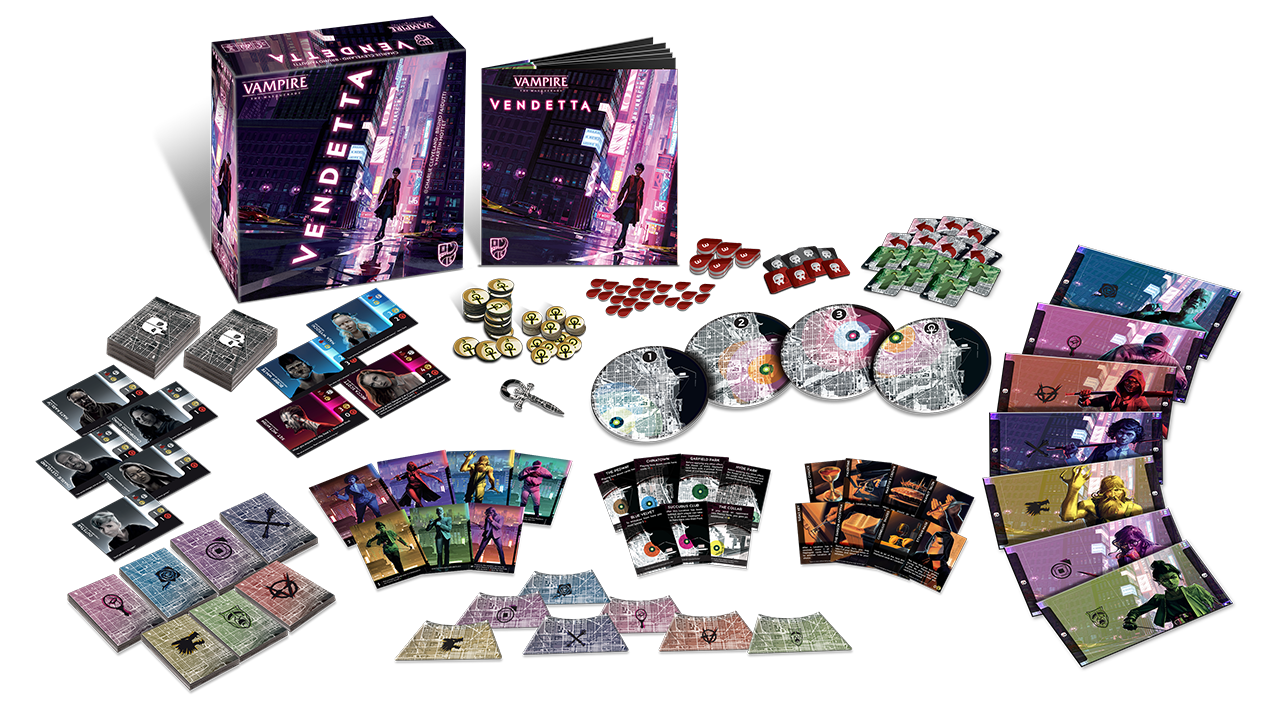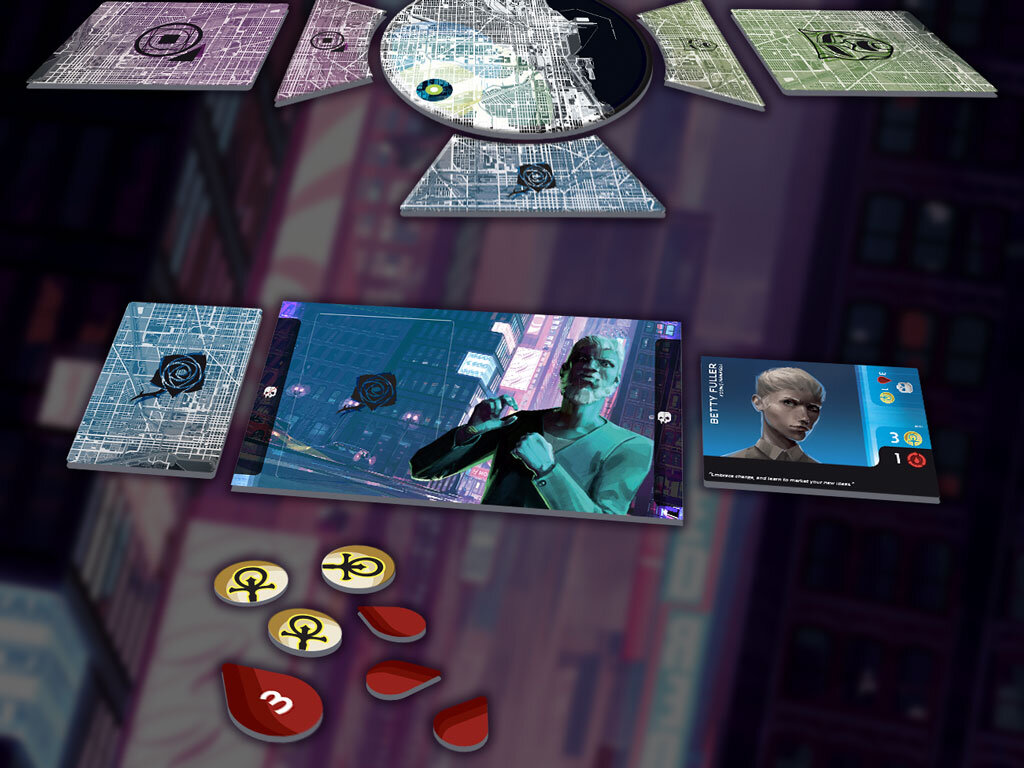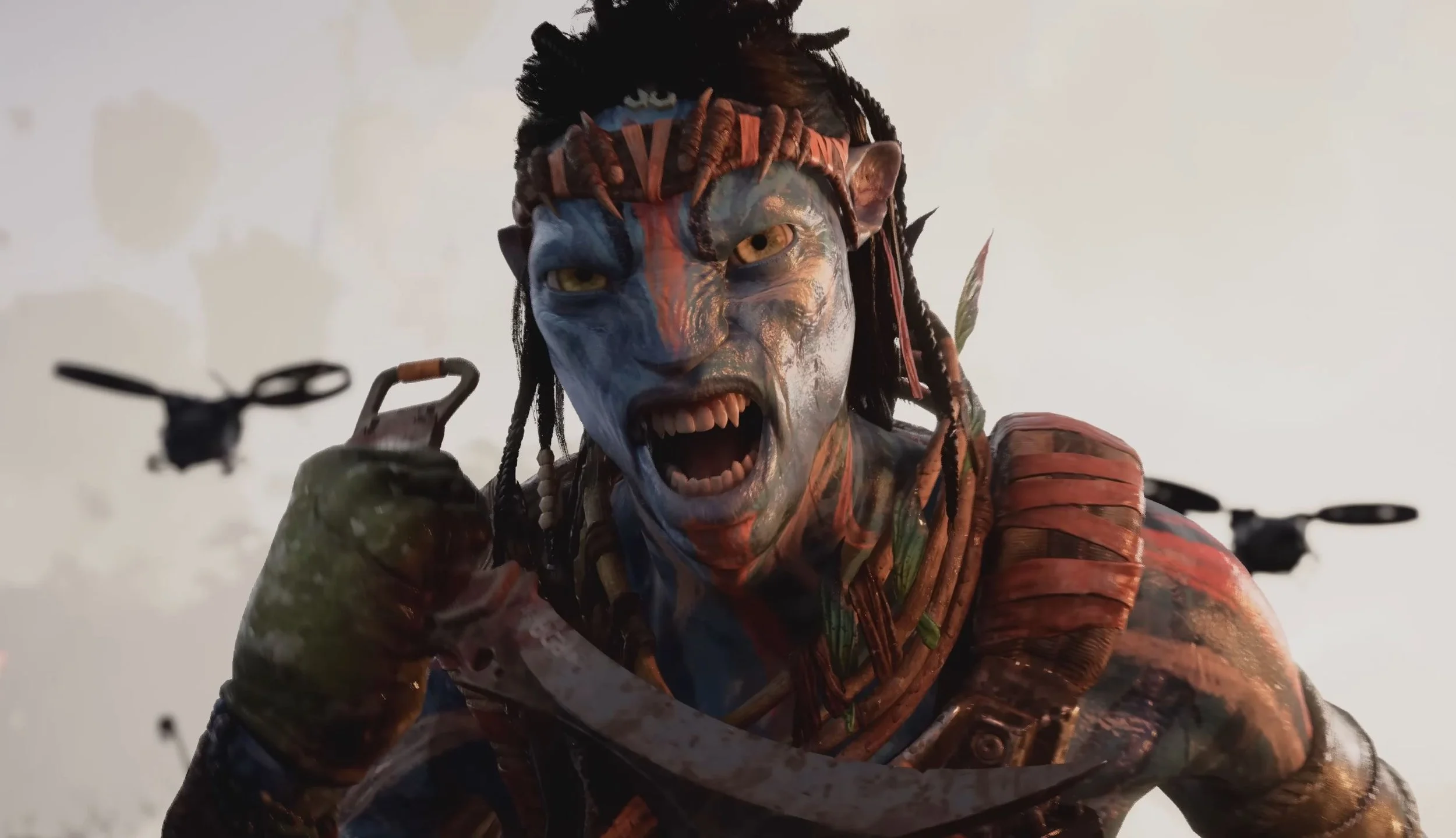Review copy provided by Horrible Guild
At the end of September, I tried out Vampire: The Masquerade - Vendetta at the Castle TriCon event and shared my thoughts on the upcoming competitive card game. The asymmetric tabletop clash comes from Horrible Guild—the team behind The King’s Dilemma—after successfully funding on Kickstarter in April of this year.
The Camarilla is back in this biting return to the World of Darkness and each clan is vying for control of the city of Chicago. That’s where the asymmetry comes into play because the clans all boast different powers and tactics in their pursuit of power. I’m happy to have the physical copy now, as playthroughs on Tabletopia can be finicky sometimes (though Vendetta plays better than most on the digital platform).
With fulfillment happening across the globe to the more than 4000 backers, the fast-paced game is ready to hit the table. And to celebrate the arrival of this blood-thirsty and influence-rich game, I’m deepening my look at the game to more thoroughly cover what’s possible with this Vampire: The Masquerade card game.
There are seven different vampire clans, location modifiers, and relics, all combining for a filling-but-fast meal. Uncork the blood (I mean, wine) and sharpen your teeth (sorry, knives) as we dig into the victim (er, meat) of this game.
STORY
Chicago. The Camarilla’s North American crown jewel. Prince Kevin Jackson skillfully rose to power after a gruesome war with the werewolves, and has been ruling the city with a firm grasp ever since. The Camarilla Kindred of Chicago don a peaceful veneer, happy to fake support for their Prince, but in secret, some are conducting a proxy war to overthrow him…
I really like the World of Darkness. I’m a backer on Vampire: The Masquerade - Chapters on Kickstarter, I’ve thoroughly enjoyed the world-building that Vendetta has accomplished during my games, and I’m interested in several other VtM and WoD games being revealed and released.
There is something about vampires that just excites readers, viewers, and gamers. Buffy the Vampire Slayer. Angel. Blade. Dracula. Preacher. Definitely What We Do in the Shadows if you haven’t seen it. Hell, even The Vampire Diaries. It’s always going to be an intriguing topic, but the World of Darkness properties explore this territory in a very grim and mature way that roleplayers and tabletop gamers respond to—thirstily.
So Chicago is open for business. May the best vampire clan win. But don’t think it’s going to be easy because vampires are nothing if not sadistic and clever creatures. Watch your back.
GAMEPLAY
Looking at it, and even playing it, you would think that Vendetta is a medium-weight game. It’s really not. The depth and replay value of the game pull it into the realm of games like that, but it’s really quite simple once you start. Each player controls one of the Camarilla clans of Chicago—Brujah, Gangrel, Malkavian, Nosferatu, Toreador, Tremere, or Ventrue. The goal of the game is to accrue enough Influence in the city to take over at the end of the game, besting the other vampire clans that are out to seize Chicago.
There are three rounds during which players will play cards from their deck and allocate blood in order to amass power at one or more of the locations in the city. Once all players have placed their cards, the locations are resolved by activating powers in turn order and counting the total power that each player has built. The winner gets the biggest spoils, but those that come in second and third place still gain Influence, and maybe a Victim here or there. As the rounds progress, it’s important to build your Alliance of Victims and Allies (both Human and Vampire) in order to gain more Blood and Influence. Whoever manages their Alliance effectively and employs their clan-specific cards judiciously will come out on top.
Players draw new cards from their decks at the beginning of rounds and because they always play until they have one card left, then each round is bigger than the last, which increases the complexity and heightens the uncertainty as players have to weigh their options and deduce what their opponents will play, and where.
Face-up cards are visible to all players throughout the round, but facedown cards (which cost a Blood token) hide the intentions of the active player and make everyone pause as they consider this new complication. Another factor that raises doubt is the potential for players to Stay or Withdraw. Before a location is resolved, all players with cards there select one of those two options facedown. When it’s revealed, players who withdrew move all of their cards to the final locations (Prince’s Haven) and their deployed Blood back to their pool. It can give players a surprise advantage when moving additional cards into a spot that previously had little or none.
Additional rules—like Draining, Frenzy, Diablerie, Location cards, and Relic cards—affect the outcome of the game somewhat, but the basic rules are straightforward and you can quickly get a game in, whether in person or digitally through platforms like Tabletopia.
Vendetta fits into a category that is just starting to become a bigger feature on my shelves: games that feel light and approachable, play in under an hour, yet still retain enough complexity that it will appease me and any other more serious gamers who are joining the night while not scaring off friends and family that don’t want a heavy strategy game. I just finished reviewing Escape the Dark Sector recently and it gave me the same vibes.
I enjoyed Alone, another game from Horrible Guild, but this is my favorite experience yet from the publisher. I’m now interested in trying their other games that I’ve missed so far because Vendetta bites hard and doesn’t let go until someone has taken over Chicago. With seven different clans, who that will be is a question up to the savviest and most savage players who sit down at the table.
VISUALS
The artwork from Martin Mottet, as well as the graphic design from Noa Vassalli and Rita Ottolini, make for a splendid visual experience.
I love the dark color palette that reflects a shadowy world where vampires are real and they control the city behind the scenes. Grey and blue cards signify the Victims and the Human Allies, giving them a washed-out, bleak appearance that matches the theme of the game. The Vampire decks are full of neon colors and bold strokes, signifying life and vigor, albeit soaked in blood. And blood can’t be ignored on the violent red cards of the Vampire Allies, who provide support to the clans during the struggle over the city. Blood and influence tokens also mirror the two most important elements in the game—the pulsing resource that keeps all vampires alive and empowered and the measure of strength that each Clan wields in Chicago. The backs of the cards also display a grid of streets and buildings that evoke a massive urban sprawl.
It’s artwork and component quality like this that make me wish for deluxe component upgrades. My wallet is groaning quietly somewhere.
The graphic design is another triumph that makes the game so discernible to familiar and new players alike. Using the player mat above as a reference, clan decks nicely sit on the main slot, giving players easy access to their decks between rounds. Allies are positioned to the right with their Influence and Blood contribution clearly shown. If any Allies are drained, they are rotated ninety degrees and positioned on the left side of the player mat, with the new Influence and Blood stats easily seen in this new configuration.
City locations are circular, enabling all players to nestle their Clan tiles against the tile. This provides a compartmentalized fight between the Clans with cards separated in easy-to-read rows. And since the Influence and Blood tokens are so vivid in color, they visually pop when near the more muted pastel colors of player mats and cards.
Between the art and the graphic design, Vendetta is both a pleasure to look at and a joy to play.
REPLAYABILITY
Asymmetry—done right—is one of my favorite mechanisms in a board game. And the clans in the card game are very diverse, with offensive and defensive maneuvers that feel very powerful and satisfying. Even if there are no future expansions with additional Camarilla clans, the existing seven should give players enough variability to enjoy play for a long time.
Besides gameplay variants that include an interesting tag team mode, there are also optional cards that can introduce another layer of strategy. Location cards and Relic cards, respectively, offer special effects on each location within the city and player powers that activate once per game.
If additional content is released down the road containing more cards for the existing clans or new vampire alliances, then I’ll be even happier than I already am. It’s surprising when a card game this quick is imbued with an intricate system of asymmetric abilities. Vendetta feels like a featherweight boxer, light on the feet while packing a mean punch.
WHAT IT COULD HAVE DONE BETTER
One of the biggest issues with Kickstarter games is availability after initial fulfillment. If the company doesn’t print an excess of games, then tabletop gamers who missed or opted out of the crowdfunding campaign can have a hard time getting the board game. Same with any of the add-ons or component upgrades. If you have the funds or the know-how to get in on the initial Kickstarter, then you’re golden. But if you miss it for some reason, you can be left out in the cold. And with the pandemic delaying production and shipping on most games, it might be some time before a second printing goes underway. If at all, depending on the game.
Thankfully, Horrible Guild has proven with The King’s Dilemma that they’ll print the game again, so here’s to hoping that Vendetta gets the same treatment.
Another thing that will take some time to figure out is balancing. In the two games that I played which featured the Toreador, they won due to the size of their alliance. Their cards are designed to win them Victims and Allies, which in turn increase the strength of their cards. This is an intriguing style of play unique to the Toreador, but I wonder if it’s too strong as the engine gives them more cards in the Alliance, which all score toward Influence points at the end (and help to mitigate the chance of draining a Vampire) and also increase the power of their cards (which helps them win yet more Victims and Allies from the different locations). The cycle seems potent and may be too effective in accruing more Influence than other clans.
It may just be something that straightens out over numerous plays, but I’ll be curious to see what the “rankings” are for the clans, just like the win-ratio of the factions in Scythe. Those clan or faction differences can make or break how a game feels for new players. So, if there are balance concerns after more data comes in from all of the players, I would like to see an errata or clan-balancing sent out from Horrible Guild as Stonemaier Games did with Scythe and Tapestry.
VERDICT
My hands-on experience has made me double down on my appreciation for what Vampire: The Masquerade - Vendetta has to offer. While playtime doesn’t always hover around the 30 minutes that the designers suggest, veteran players can winnow down the length as they develop an understanding of the different clans and their powers. The third and final round is still a slower process as players weigh all of the probable outcomes with the higher output of player cards and abilities.
The asymmetry and variable mechanics, though, really do giveVendetta a lot of oomph for such a small footprint. Tension and anxiety abound in the second half of the game and it’s an exciting conflict of willpower and cunning. It feels like a war. It feels like a frenzied bloodbath. It feels like vampires giving no quarter. And it feels like another world apart from our own… or hidden in the shadows.
With stylish art, slick gameplay progression, and stellar replay value, Vendetta is an accomplishment for which I must commend Charlie Cleveland and Bruno Faidutti. The designers took on the World of Darkness and came out alive, with Chicago clenched tightly in their fist.

























